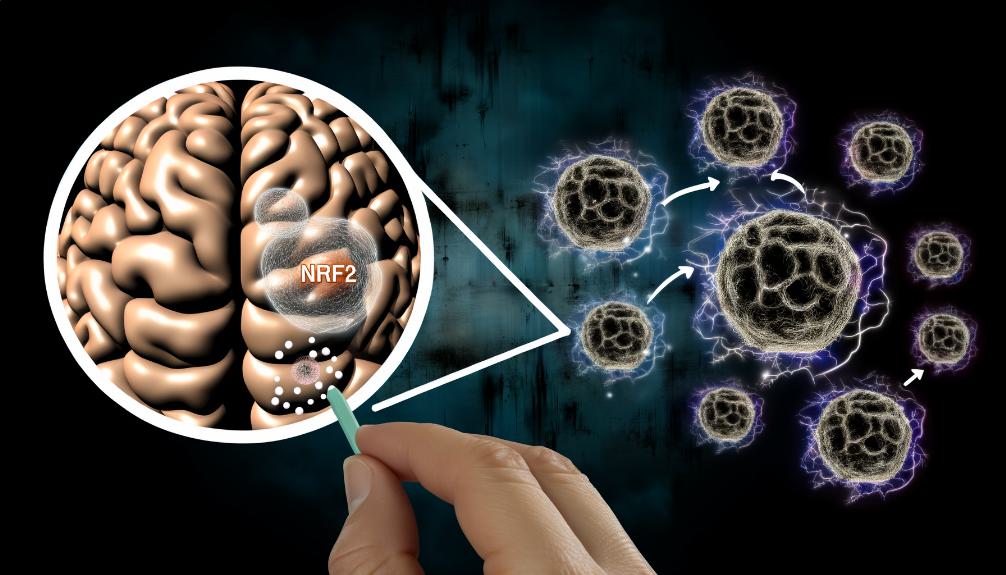
Imagine navigating a dense forest, much like a neuron navigating the complexities of oxidative stress and inflammation. Here, the Nrf2 signaling pathway acts as a crucial guide, determining the fate of neuronal survival or death.
You're aware that neurodegeneration is a multifaceted process, where oxidative stress plays a notorious role, and Nrf2's ability to modulate cellular defense mechanisms is paramount. Studies have shown that Nrf2 activation can mitigate damage and improve outcomes in models of neurodegenerative diseases.
However, the intricacies of how Nrf2 operates and its therapeutic potential remain a lively area of investigation. The question then arises: How exactly does Nrf2 orchestrate its protective roles, and what challenges do we face in translating this knowledge into tangible treatments for neurodegenerative disorders?
This is where our journey into the depths of cellular defense mechanisms begins, inviting a closer examination of Nrf2's pivotal role in combating neurodegeneration.
Understanding Nrf2 Signaling
To grasp the role of Nrf2 signaling in neurodegeneration, it's crucial to understand that Nrf2 is a transcription factor pivotal for cellular defense against oxidative stress. This protein plays a central part in gene regulation, particularly in the context of signaling mechanisms that protect cells from harmful stimuli. Nrf2's pathway is intricately linked with its ability to regulate the expression of antioxidant proteins that safeguard the nervous system from oxidative damage and inflammation, both of which are key contributors to neurodegenerative diseases.
Your understanding of Nrf2 signaling must include its activation and regulation processes. Normally, Nrf2 is kept in the cytoplasm by its inhibitor, Keap1. However, upon oxidative stress, Nrf2 is released from Keap1, translocates to the nucleus, and binds to antioxidant response elements (ARE) in the DNA. This binding initiates the transcription of genes responsible for antioxidant production and detoxification processes.
Analyzing these signaling mechanisms, you'll find that Nrf2's role isn't just to combat oxidative stress but also to regulate a network of genes critical for neuronal survival. This regulation is a highly orchestrated process, indicating the complexity of Nrf2's function in maintaining cellular homeostasis and preventing neurodegenerative conditions.
Nrf2 in Cellular Defense
Nrf2 serves as a master regulator of cellular defense mechanisms, orchestrating the protection against oxidative damage and ensuring the survival of neurons amidst neurodegenerative conditions. By activating transcription of antioxidant response element (ARE)-driven genes, Nrf2 plays a pivotal role in the cellular defense system. It's not just about activating these genes; it's about the precise regulation and timing of this activation that's crucial for maintaining cellular homeostasis.
Dietary influences have a significant impact on Nrf2 activity. Certain phytochemicals found in fruits and vegetables can enhance Nrf2 activity, leading to an upregulation of antioxidant and cytoprotective genes. This dietary modulation of Nrf2 signaling represents a promising avenue for neuroprotective strategies, highlighting the importance of diet in gene regulation and cellular defense.
Gene regulation, under the influence of Nrf2, involves a complex interplay of various signaling pathways. Nrf2's ability to sense oxidative stress and then initiate a defensive response is a testament to its role as a cellular guardian. This orchestrated response includes not only the detoxification and removal of reactive oxidative species but also the repair of damaged proteins and DNA, ensuring cellular resilience and survival in the face of neurodegenerative challenges.
Neurodegeneration and Oxidative Stress
Understanding the role of Nrf2 in cellular defense sets the stage for comprehending how oxidative stress underpins neurodegeneration, a condition where neurons progressively deteriorate and lose function. You're stepping into a realm where the balance between the production of reactive oxygen species (ROS) and the body's ability to counteract their harmful effects is crucial. When this balance tips, oxidative stress occurs, playing a pivotal role in the initiation and progression of neurodegenerative diseases.
Dietary factors and genetic predispositions significantly influence this delicate balance. Certain foods can either exacerbate or mitigate oxidative stress, directly impacting neuronal health. For instance, diets rich in antioxidants can bolster the body's defenses against ROS, potentially slowing the progression of neurodegeneration. On the other hand, genetic predispositions can render some individuals more susceptible to oxidative damage, highlighting the intricate interplay between genes and environment in neurodegenerative diseases.
This complex scenario underscores the importance of understanding individual risk factors, including dietary habits and genetic makeup, in the context of neurodegeneration. It's clear that oxidative stress isn't just a bystander in neurodegeneration; it's a central player, influenced by both environmental and genetic factors, shaping the landscape of neuronal health and function.
Nrf2 Pathway Activation
Activating the Nrf2 pathway represents a crucial strategy in combating the oxidative stress implicated in neurodegenerative diseases. This pathway's activation triggers the expression of antioxidant proteins, which neutralize harmful free radicals, thus offering a protective mechanism against neuronal damage. You'll find that dietary influences play a significant role in modulating this pathway. Certain foods, rich in sulforaphane or curcumin, for instance, can enhance Nrf2 activity, providing a natural means to bolster your body's defense against neurodegeneration.
However, it's not solely about what you eat. Genetic polymorphisms in the Nrf2 pathway also dictate its efficiency in responding to oxidative stress. Variations in genes encoding for Nrf2 or its inhibitor, Keap1, can significantly impact the pathway's activity. Individuals with certain polymorphisms may exhibit a heightened or diminished response to oxidative challenges, influencing their susceptibility to neurodegenerative conditions. This genetic aspect underscores the personalized nature of potential Nrf2-targeted interventions.
Understanding the intricate balance between dietary influences and genetic predispositions in Nrf2 pathway activation offers a nuanced approach to mitigating neurodegeneration. It highlights the importance of personalized dietary recommendations and the potential for genetic screening in developing targeted therapies.
Therapeutic Potential of Nrf2
Given the critical role of dietary and genetic factors in modulating the Nrf2 pathway, exploring its therapeutic potential emerges as a promising avenue in the fight against neurodegenerative diseases. You'll find that dietary influences can significantly enhance Nrf2 activation. Foods rich in sulforaphane, for instance, have been shown to boost Nrf2 activity, offering neuroprotective effects by mitigating oxidative stress and inflammation, two key culprits in neurodegeneration.
Moreover, understanding genetic variations that affect Nrf2 signaling is crucial. Certain polymorphisms in the NFE2L2 gene, which encodes Nrf2, can influence the pathway's efficiency. This genetic insight opens the door to personalized medicine, where therapies could be tailored based on an individual's genetic makeup, maximizing the therapeutic benefits while minimizing adverse effects.
However, the interplay between dietary components and genetic predispositions underscores the complexity of harnessing Nrf2's therapeutic potential. The right balance of dietary triggers and understanding individual genetic variations could significantly enhance the efficacy of Nrf2-targeted therapies. Through meticulous research and clinical trials, leveraging these factors could lead to breakthroughs in treatments for neurodegenerative disorders, offering hope to millions affected worldwide.
Challenges in Nrf2 Research
Exploring the therapeutic potential of Nrf2 in neurodegeneration, researchers face significant challenges, including the intricate balance between activation mechanisms and potential side effects. You're navigating a complex landscape where gene variability plays a crucial role. This variability affects how individuals respond to potential Nrf2-targeted therapies, making it difficult to predict efficacy and safety across diverse populations.
Moreover, research methodologies themselves present hurdles. You're often limited by the models available to study Nrf2's role in neurodegenerative diseases. These models mightn't fully replicate human disease pathology or the nuanced regulation of the Nrf2 pathway in humans. Consequently, translating findings from bench to bedside becomes a formidable task.
You must also consider the dual nature of Nrf2 activation. While it's protective in many contexts, inappropriate or excessive activation could have adverse effects, including promoting cancer growth. This delicate balance necessitates precise targeting strategies in therapeutic development, which are challenging to design and optimize.
Conclusion
In conclusion, you've seen how vital Nrf2 signaling is in combating neurodegeneration. By bolstering cellular defense against oxidative stress, activating the Nrf2 pathway presents a promising therapeutic avenue.
However, challenges remain in fully harnessing its potential, given the complexity of its mechanisms and the need for precise modulation. Continued research is imperative to unravel these complexities, paving the way for innovative treatments that could significantly alter the landscape of neurodegenerative disease management.
Please validate any information here with a healthcare professional. The content is provided for education purposes, This content has not been evaluated by the Food and Drug Administration. Any advice or products mentioned is/are not intended to diagnose, treat, cure, or prevent any disease,










